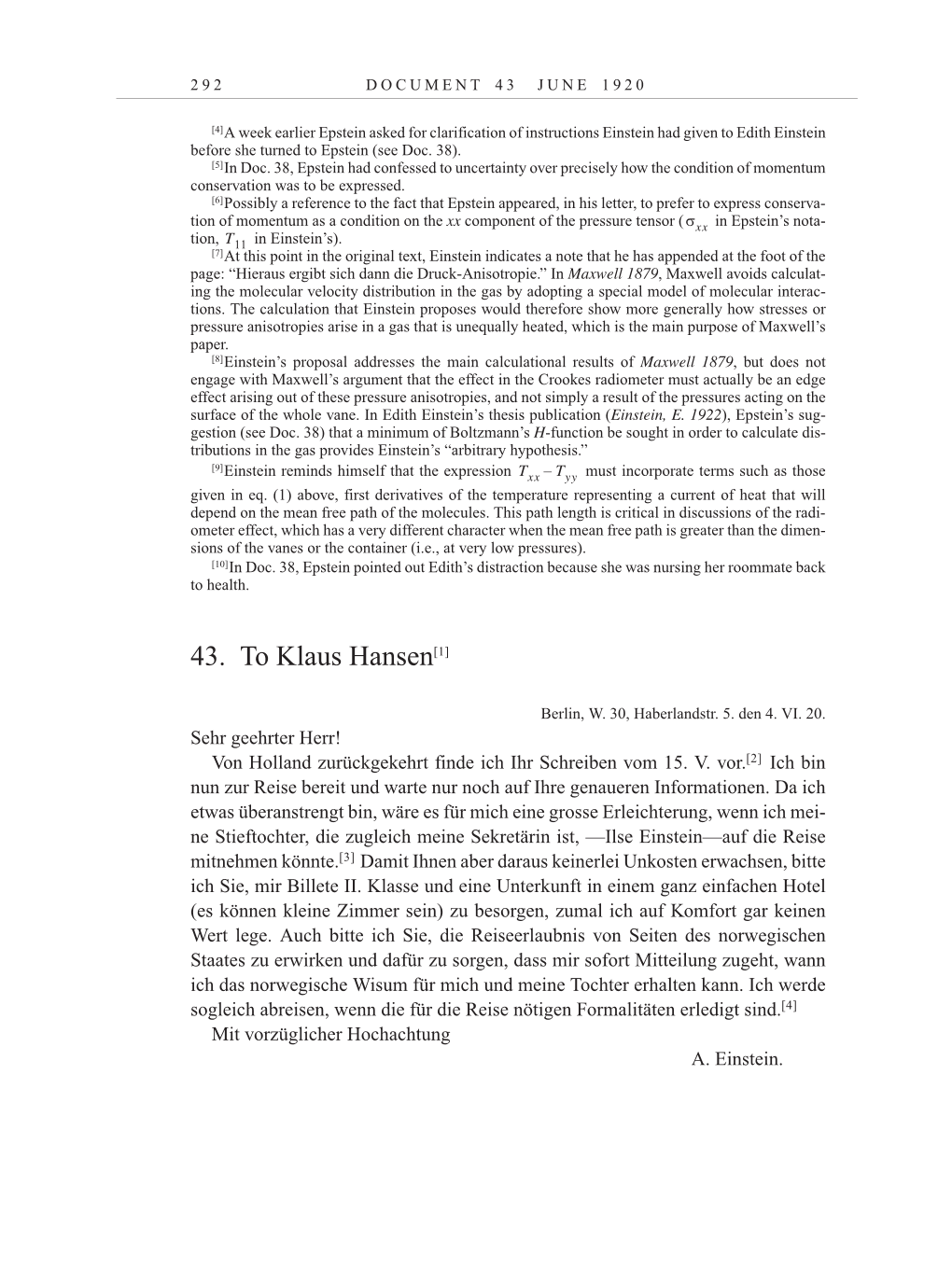2 9 2 D O C U M E N T 4 3 J U N E 1 9 2 0
[4]A week earlier Epstein asked for clarification of instructions Einstein had given to Edith Einstein
before she turned to Epstein (see Doc. 38).
[5]In Doc. 38, Epstein had confessed to uncertainty over precisely how the condition of momentum
conservation was to be expressed.
[6]Possibly a reference to the fact that Epstein appeared, in his letter, to prefer to express conserva-
tion of momentum as a condition on the xx component of the pressure tensor ( in Epstein’s nota-
tion, in Einstein’s).
[7]At this point in the original text, Einstein indicates a note that he has appended at the foot of the
page: “Hieraus ergibt sich dann die Druck-Anisotropie.” In Maxwell 1879, Maxwell avoids calculat-
ing the molecular velocity distribution in the gas by adopting a special model of molecular interac-
tions. The calculation that Einstein proposes would therefore show more generally how stresses or
pressure anisotropies arise in a gas that is unequally heated, which is the main purpose of Maxwell’s
paper.
[8]Einstein’s proposal addresses the main calculational results of Maxwell 1879, but does not
engage with Maxwell’s argument that the effect in the Crookes radiometer must actually be an edge
effect arising out of these pressure anisotropies, and not simply a result of the pressures acting on the
surface of the whole vane. In Edith Einstein’s thesis publication (Einstein, E. 1922), Epstein’s sug-
gestion (see Doc. 38) that a minimum of Boltzmann’s H-function be sought in order to calculate dis-
tributions in the gas provides Einstein’s “arbitrary hypothesis.”
[9]Einstein reminds himself that the expression must incorporate terms such as those
given in eq. (1) above, first derivatives of the temperature representing a current of heat that will
depend on the mean free path of the molecules. This path length is critical in discussions of the radi-
ometer effect, which has a very different character when the mean free path is greater than the dimen-
sions of the vanes or the container (i.e., at very low pressures).
[10]In Doc. 38, Epstein pointed out Edith’s distraction because she was nursing her roommate back
to health.
43. To Klaus Hansen[1]
Berlin, W. 30, Haberlandstr. 5. den 4. VI. 20.
Sehr geehrter Herr!
Von Holland zurückgekehrt finde ich Ihr Schreiben vom 15. V. vor.[2] Ich bin
nun zur Reise bereit und warte nur noch auf Ihre genaueren Informationen. Da ich
etwas überanstrengt bin, wäre es für mich eine grosse Erleichterung, wenn ich mei-
ne Stieftochter, die zugleich meine Sekretärin ist, —Ilse Einstein—auf die Reise
mitnehmen könnte.[3] Damit Ihnen aber daraus keinerlei Unkosten erwachsen, bitte
ich Sie, mir Billete II. Klasse und eine Unterkunft in einem ganz einfachen Hotel
(es können kleine Zimmer sein) zu besorgen, zumal ich auf Komfort gar keinen
Wert lege. Auch bitte ich Sie, die Reiseerlaubnis von Seiten des norwegischen
Staates zu erwirken und dafür zu sorgen, dass mir sofort Mitteilung zugeht, wann
ich das norwegische Wisum für mich und meine Tochter erhalten kann. Ich werde
sogleich abreisen, wenn die für die Reise nötigen Formalitäten erledigt sind.[4]
Mit vorzüglicher Hochachtung
A. Einstein.
xx
T11
Txx Tyy –
